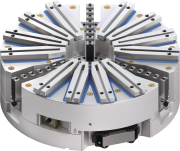ChrisE
Plastic
- Joined
- Oct 10, 2020
- Location
- Mukilteo, WA
We just started a new prototype job made of annealed 1 inch plate 4340 steel that was sent out to waterjet cut into rings (7.4" OD, 5.7" ID).
Due to the size of the part, we had to use a 3-jaw chuck. But because of the mechanical properties of the final part, traditional chuck jaws were bending it into a triangular elliptical shape on the 2nd op, so we bought and switched to pie jaws so the higher surface area would distribute the clamping force more evenly on the ID during 2nd op where most of the final dimensions are being cut. I even made sure the chuck jaws were indicated nice and center within .001" on a 100 degree sweep of the outside of the jaws.
Chuck pressure during 2nd op roughing is 1.5MPA (217.6 psi), and finishing pressure is 1.0MPA (145 psi). Roughing with .032R inserts, SFM is 550, DOC is .03", and .008" feedrate. Finishing is done with .016R inserts, 550sfm, .01 DOC, and .0035 feedrate.
Final OD is 7.125" +0/-.001", final ID is 6.0" +/-.01", but only .3" from the back of the part, the rest has a funky profile.
I was careful to measure along multiple points while the part was still in the jaws after it had finished, it measured nice and round and i managed to land it nearly dead-center of the tolerance. But when I took the part out to measure it, it was elliptical by .004 and undersized to boot. I'm not sure what caused this, but I had plenty of coolant, so I can't imagine it was heat buildup, and the material was supposedly annealed. Thoughts?
edit: specified that 1st op didnt come out elliptical and that problems arise on 2nd op
Due to the size of the part, we had to use a 3-jaw chuck. But because of the mechanical properties of the final part, traditional chuck jaws were bending it into a triangular elliptical shape on the 2nd op, so we bought and switched to pie jaws so the higher surface area would distribute the clamping force more evenly on the ID during 2nd op where most of the final dimensions are being cut. I even made sure the chuck jaws were indicated nice and center within .001" on a 100 degree sweep of the outside of the jaws.
Chuck pressure during 2nd op roughing is 1.5MPA (217.6 psi), and finishing pressure is 1.0MPA (145 psi). Roughing with .032R inserts, SFM is 550, DOC is .03", and .008" feedrate. Finishing is done with .016R inserts, 550sfm, .01 DOC, and .0035 feedrate.
Final OD is 7.125" +0/-.001", final ID is 6.0" +/-.01", but only .3" from the back of the part, the rest has a funky profile.
I was careful to measure along multiple points while the part was still in the jaws after it had finished, it measured nice and round and i managed to land it nearly dead-center of the tolerance. But when I took the part out to measure it, it was elliptical by .004 and undersized to boot. I'm not sure what caused this, but I had plenty of coolant, so I can't imagine it was heat buildup, and the material was supposedly annealed. Thoughts?
edit: specified that 1st op didnt come out elliptical and that problems arise on 2nd op
Last edited:



